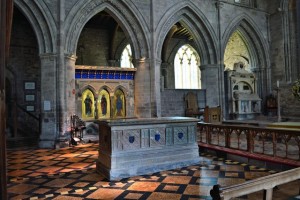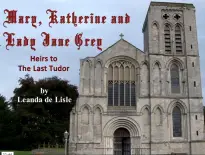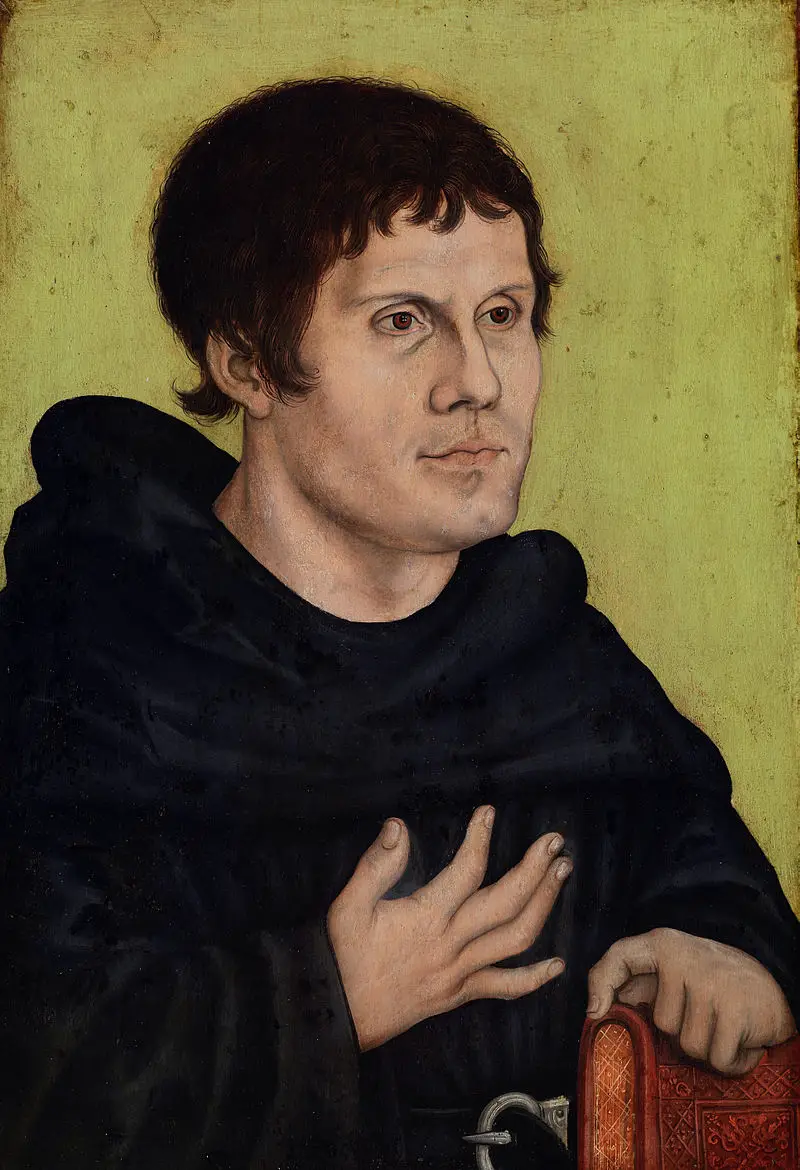 On this day in 1456, Edmund Tudor, 1st Earl of Richmond and father of King Henry VII, died from the plague at Carmarthen Castle in Wales.
On this day in 1456, Edmund Tudor, 1st Earl of Richmond and father of King Henry VII, died from the plague at Carmarthen Castle in Wales.
Edmund was the eldest son of Owen Tudor and Catherine of Valois (widow of Henry V and mother of Henry VI). He was born around 1430 in Much Hadham, Hertfordshire, and is sometimes known as Edmund of Hadham. Edmund was made Earl of Richmond by his half-brother, Henry VI, on 23rd November 1452 and his brother, Jasper, was made Earl of Pembroke. The brothers were knighted on 5th January 1453 and in March 1453, at the Reading Parliament, they received recognition as the king's true and legitimate brothers.
On 24th March 1453, Henry VI granted the wardship and marriage of ten-year-old Lady Margaret Beaufort, daughter and heir of John Beaufort, Duke of Somerset, and a direct descendant of John of Gaunt, Duke of Lancaster, to Edmund and Jasper. By November 1455, Edmund had married Margaret and had moved to south-west Wales where, by August 1456, after a conflict with Gruffudd ap Nicholas, he had taken control of Carmarthen Castle "and thereby captured the centre of royal government in the region" on behalf of the king. A Yorkist force of 2,000 men led by Sir William Herbert and Sir Walter Devereux then marched on Carmarthen. They successfully seized the castle and Edmund was imprisoned temporarily. He died at Carmarthen from the plague on 1st November 1456 aged about twenty-six. Edmund was buried at the monastery of Greyfriars in Carmarthen, but was moved to St Davids Cathedral on the orders of his grandson, Henry VIII, after the dissolution of the monastery. His elaborate tomb can still be seen today in the middle of the high altar, although his effigy and other decorations were removed during the Civil War in the 17th century. His elegy was written by Lewys Glyn Cothi, the Welsh poet.
Edmund's widow, Margaret, was six months pregnant when he died. She gave birth at her brother-in-law's home of Pembroke Castle on 28th January 1457. The baby was a boy, a son who would become King Henry VII.
Notes and Sources
Picture: The shrine of St David and the tomb of Edmund Tudor, died 1456
cc-by-sa/2.0 - © Philip Pankhurst - geograph.org.uk/p/4585486.
- Thomas, R. S.. “Tudor, Edmund, first earl of Richmond (c.1430–1456).” R. S. Thomas In Oxford Dictionary of National Biography, edited by H. C. G. Matthew and Brian Harrison. Oxford: OUP, 2004. Online ed., edited by David Cannadine, January 2008.
- Ridgway, Claire (2012) On This Day in Tudor History, MadeGlobal Publishing.



Edmund Tudor really got a better tomb after the Dissolution with being moved to Saint David’s Cathedral, which other Tomb was pilgrimage site for many decades afterwards. In the Mapping Survey Great Britannia under Charles ii the road to Saint David was still being used by pilgrims. It is used again today.
I have a question. What do you think about the idea that Edmund Tudor was not the son of Owen Tudor, whose body is now lost, but Edmund Beaufort, the other lover of Katherine de Valois. I have my own opinion, but I just wondered what someone else thought.
Thanks
I’ve heard of that theory but haven’t looked at the detail behind it. I’m reading Nathan Amin’s “House of Beaufort” but I haven’t reached that period yet. (Great book.) I’ll be interested to hear opinions on this.
I believe Edmund and Jasper were half-brothers to Henry VI rather than step brothers.
Maybe they are both. They are stepbrothers because their mother married both father’s, half brothers because they had different fathers but the same mother. Half brother is probably a more accurate term as the marriage of Catherine de Valois and Owen Tudor was without the permission of the Council and therefore against the law. She was forbidden to marry by Act of Parliament while her son was a minor. Her marriage could have been seen as null and void and her children illegitimate. Half brother would be legally correct in that case.
Of course, Edmund Tudor may not have been Owen’s son as many speculated back then, but the son of Edmund Beaufort, making Margaret Beaufort ‘s husband her first cousin. This would be incest. This rather contentious claim was made by historian G.L. Harriss and the late historian, John Ashdown Hill. The claim is discounted by Nathan Amin in his work on House of Beaufort, quite expertly. However, Catherine did have an affair with Edmund before Owen and intended to marry him. As this also overlapped her relationship with Owen the speculation is that Catherine was pregnant when she “married” Owen Tudor . Modern historians point out that there is no surviving evidence for a marriage service between Catherine de Valois and her steward, Owen Tudor but this misses the point of Medieval Canon Law. No formal marriage ceremony was necessary, no marriage licence existed and no contract was needed for a marriage to be valid. You didn’t even need clergy ( you still don’t in theory as a couple marry each other and the priest is there to facilitate the sacrament) but you needed two things to make a valid marriage.
You needed consent, both parties had to agree and not be forced into marriage.
You had to promise to live as man and wife and consummate the marriage.
Now it was a bit more complex but the Church recognised this as a marriage. It also helped if you had a couple of witnesses and a priest to perform a simple ceremony. Much like now, you could get hitched almost anywhere, the place did not need to be a Church and it didn’t require a license. However, ideally you were married at the Church door, in front of many witnesses, with a clergyman present, then everyone went inside for Mass and you had a party and a bedding to follow. The bans would have been read in advance and you made some kind of contract. However, people did slip of quite often to marry as above, causing a nightmare for the Church Courts who had to deal with angry parents trying to dissolve this type of marriage and often failing. Under pressure a groom may say it didn’t happen because his parents had a noble woman with land lined up for him, but he still could not be forced.
Catherine and Owen lived together as man and wife and four children certainly confirmed the relationship was consummated and it was recognised because Owen was put in prison because of it. There was also a number of references to their wedding, of whatever variety it took in contemporary sources, they claimed to be married and have witnesses, so I don’t think it was in serious doubt. Henry vi would later confer land and titles on his half brothers and he deemed Edmund a suitable bridegroom for his cousin, Lady Margaret who was a wealthy heiress and Owen certainly didn’t look at sons as anything but his legitimate sons. Edmund Beaufort was Edmund Tudors Godfather, but so what, he was related to him and a leading noble at the time. Edmund was also born on the feast of Saint Edmund, hence his name. We can’t know if he really did have dubious parenthood, anything is possible, but without DNA or evidence, it is unlikely that we will ever know. Personally, I believe Edmund and Jasper Tudor were the legitimate children of Catherine de Valois and Owen Tudor, because there is no evidence that she had a sexual relationship with Edmund Beaufort or was pregnant at the time of her marriage. I don’t go with dubious evidence about the coat of arms being too close to the Beaufort one, even if they are similar as evidence of parenthood. It makes for interesting debate, but there is only one kind of evidence which holds up in the 21st century and unless we have that, I am with Owen Tudor and saying all of his presumed sons are his.
Yes, that is correct, I don’t know why I put step! Thank you!
I’ve always wondered why it’s widely accepted that Owen and Catherine never married, or at least heavily doubted. I know no marriage record has been found, but one hasn’t been found for Edward IV and Elizabeth Wydvil either (and while there is the bigamy question there, few doubt they wed). Owen was jailed for marrying the dowager queen, pardoned by Henry IV, and Henry acknowledged Edmund and Jasper as his true and legitimate brothers. It seems Henry was convinced!
Speaking of that Reading Parliament, did it mention any other Tudor children besides Edmund and Jasper? I’ve seen up to 6 children listed for Owen and Catherine, most at least list a 3rd brother, Owen the monk, though I find no concrete evidence on him either. What am I missing? I know a parliamentary acknowledgement of Edmund and Jasper’s knighthood and earldoms would not require a declaration of any other Tudor children but it seems a bit odd to leave them out of an official declaration that they were members of Henry’s family…
Last question (promise): I remember reading that the creation of the earldoms for the Tudor brothers included a declaration that they ranked above all other earls, ranked only below the king himself and royal dukes. Any thoughts that Henry might have been making preliminary moves to declare them his heirs if he failed to get a son? Henry VIII considered weirder options, and the brother’s COA was based on the royal standard, not Owen Tudor ‘s COA.
GORGEOUS tomb and cathedral!
I think they were married. At that time, all it took for a marriage to be legal and binding was the exchange of promises or vows and then consummation, there didn’t even need to be a witness, although that helped if there was any question over the marriage later.
It is not known for certain how many children they had. “A chronicle of London, from 1089 to 1483; written in the fifteenth century” states that Owen and Catherine were married amnd that they had “iii or iiij chyldren” – see https://archive.org/details/chronicleoflondo00nicouoft/page/n135 p. 123.
Interesting query about the earldoms. Hmmm… I’m not sure.
Edmund was made Earl of Richmond and Jasper Earl of Pembroke in 1452 before their knighthood the following year. Their elevation to being above all other Earls was certainly unprecedented and normally only for Royal children. It’s certainly a recognition of their bloodline.
In his biography of Owen Tudor, Terry Breverton, Tudor historian, noted four children, including Owen, plus an illegitimate son a David Owen, provided for in Royal documents and who was in Royal service at the end of his life. Yes, the Coat of Arms is based on those of the King who definitely saw his brothers as legitimate. Owen is also called Edward or Thomas although no mention of him is listed in the monastic records. A daughter Margaret who became a nun is noted. Both are noted in Polydore Virgil but not in any other sources other than the Great Chronicle of London, but from which year, I don’t recall.
No I don’t believe Henry intended his Tudor half brothers to succeed him, but to extend his recognition of them and their importance in Wales and his future service and their legitimacy. They didn’t have a good enough claim if he didn’t have a son, not with legitimate direct descendants of Edward iii, like Richard Duke of York around. It is believed by historian Matthew Lewis for example that George, Duke of Clarence was made the heir to the House of Lancaster. Another remote but recorded theory is that at his restoration Henry vi made the young Henry Tudor his future heir or at least recognised his importance by anointing him. Henry had by this time gone insane so he was perhaps seeing visions but it’s an interesting development, if it really happened.